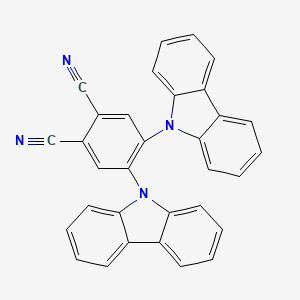2CzPN
Safety Information
Hazard Statements
Precautionary Statements
Pictograms
Product Description
2CzPN, also known as 4,5-di(9H-carbazol-9-yl)phthalonitrile, is a versatile organic compound primarily utilized in the production of OLED displays due to its excellent electron transport properties. It plays a crucial role in enhancing the efficiency and stability of these displays, contributing to the vibrant colors and low power consumption characteristic of modern electronic devices. This compound is synthesized through a series of chemical reactions involving carbazole and phthalonitrile, showcasing its importance in the manufacturing process of advanced display technologies. Its unique molecular structure allows it to effectively facilitate electron transport, making it indispensable in the development of next-generation display technologies.
Application
In applications, 2CzPN serves as an essential component in the fabrication of Organic Light Emitting Diodes (OLEDs). Its ability to transport electrons efficiently makes it ideal for use in the construction of OLED screens, which are found in smartphones, televisions, and other digital devices. Additionally, its role in improving the performance and longevity of OLEDs extends beyond just display technology; it contributes to the overall energy efficiency and durability of electronic equipment, supporting the industry's push towards sustainable and eco-friendly products.
Articles:
- Local-Excitation versus Charge-Transfer Characters in the Triplet State: Theoretical Insight into the Singlet–Triplet Energy Differences of Carbazolyl-Phthalonitrile-Based Thermally Activated Delayed Fluorescence Materials
Publication Date: November 21, 2016
Kyungeon Lee, Dongwook Kim
https://doi.org/10.1021/acs.jpcc.6b10161
- Simultaneous enhancement of efficiency and stability of OLEDs with thermally activated delayed fluorescence materials by modifying carbazoles with peripheral groups
Publication Date: 30 January 2019
Yunge Zhang, Dongdong Zhang, Taiju Tsuboi, Yong Qiu & Lian Duan
https://doi.org/10.1007/s11426-018-9413-5
- Highly Efficient Sky-Blue Fluorescent Organic Light Emitting Diode Based on Mixed Cohost System for Thermally Activated Delayed Fluorescence Emitter (2CzPN)
Publication Date: March 28, 2016
Jin Won Sun, Kwon-Hyeon Kim, Chang-Ki Moon, Jeong-Hwan Lee, Jang-Joo Kim
